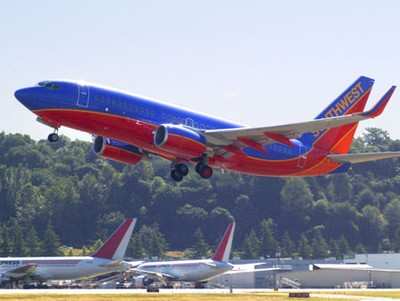Whistleblowers Allege LCC Flew Planes Without Inspections
 ANN REALTIME UPDATE
03.06.08 1600 EST: Moments ago, the Federal Aviation
Administration (FAA) announced it has initiated action to collect a
$10.2 million civil penalty from Southwest Airlines for operating
46 airplanes without performing mandatory inspections for fuselage
fatigue cracking. Subsequently, the airline found that six of the
46 airplanes had fatigue cracks.
ANN REALTIME UPDATE
03.06.08 1600 EST: Moments ago, the Federal Aviation
Administration (FAA) announced it has initiated action to collect a
$10.2 million civil penalty from Southwest Airlines for operating
46 airplanes without performing mandatory inspections for fuselage
fatigue cracking. Subsequently, the airline found that six of the
46 airplanes had fatigue cracks.
"The FAA is taking action against Southwest Airlines for a
failing to follow rules that are designed to protect passengers and
crew," said FAA Associate Administrator for Aviation Safety
Nicholas A. Sabatini. "We expect the airline industry to fully
comply with all FAA directives and take corrective action."
The FAA alleges that from June 18, 2006 to March 14, 2007,
Southwest Airlines operated 46 Boeing 737 airplanes on 59,791
flights while failing to comply with a September 8, 2004 FAA
Airworthiness Directive (AD) that required repetitive inspections
of certain fuselage areas to detect fatigue cracking.
As ANN reported earlier in the day (see below,) original
estimates had placed the amount of the likely fine to Southwest at
around $3 million. The FAA says the amount of the civil penalty
reflects the serious nature of what it says were deliberate
violations.
The FAA alleges that after Southwest Airlines discovered that it
had failed to accomplish the required repetitive inspections,
between March 15, 2007 and March 23, 2007, it continued to operate
those same 46 airplanes on an additional 1,451 flights.
Southwest Airlines has 30 days from receipt of the FAA’s
civil penalty letter to respond to the agency.
Original Report
 1500
EST: Federal inspectors alleged this week that low-cost
carrier Southwest Airlines flew at least 117 planes in violation of
mandatory checks through March of last year.
1500
EST: Federal inspectors alleged this week that low-cost
carrier Southwest Airlines flew at least 117 planes in violation of
mandatory checks through March of last year.
According to congressional documents obtained by CNN, Southwest
-- statistically, one of the safest carriers worldwide -- flew the
aircraft in passenger service for 30 months past inspection
guidelines. The report asserts those planes were "unsafe" and "not
airworthy."
Two FAA inspectors prepared the report, and have since requested
whistle-blower protection status from the House Transportation and
Infrastructure Committee. The two assert FAA managers knew of the
lapses, but opted to allow Southwest to conduct safety checks at a
slower pace as "aircraft out of service would have disrupted
Southwest Airlines' flight schedule."
Minnesota Congressman James Oberstar, who chairs the
Transportation Committee, called the inspectors' report "one of the
worst safety violations" he has ever seen. "The result of
inspection failures, and enforcement failure, has meant that
aircraft have flown unsafe, unairworthy, and at risk of lives,"
Oberstar told CNN.
 The inspectors say
Southwest did not comply with mandatory intervals for rudder system
checks on 70 of its Boeing 737s, required in the aftermath of two
fatal 737 crashes in the 1990s. The whistleblowers also assert
Southwest failed to comply with fuselage fatigue inspections on 47
more planes.
The inspectors say
Southwest did not comply with mandatory intervals for rudder system
checks on 70 of its Boeing 737s, required in the aftermath of two
fatal 737 crashes in the 1990s. The whistleblowers also assert
Southwest failed to comply with fuselage fatigue inspections on 47
more planes.
According to the documents, one of the FAA inspectors discovered
a fuselage crack on one of Southwest's 737s last year. After
notifying the airline, he checked over safety records, and
determined "dozens" of other planes had flown past the required
inspection intervals.
"Southwest Airlines at the time of discovery did not take
immediate, corrective action as required to address this unsafe
condition and continued to fly the affected aircraft with paying
passengers," the inspector's report claims.
The airline did voluntarily disclose last spring it missed some
inspections, the documents state... but the inspectors say
Southwest continued to fly the planes before inspections were
complete.
"That is wrong," said Oberstar. "When an aircraft is flying out
of compliance with airworthiness directives, it is to be shut down
and brought in for maintenance inspection. That's the law."
Oberstar plans to call for a hearing on the matter. Despite
reports that federal regulators are seeking as much as $3 million
in fines against Southwest for the alleged safety lapses, the
airline told The Wall Street Journal it has received no notice of
such a penalty.

A spokewoman for the airline added Southwest would be surprised
to receive such a fine, "considering it was Southwest that found,
disclosed and fixed this issue last March."
 Samson Sky Hits the Wind Tunnel
Samson Sky Hits the Wind Tunnel ANN's Daily Aero-Term (05.22.24): LAHSO
ANN's Daily Aero-Term (05.22.24): LAHSO Aero-FAQ: Dave Juwel's Aviation Marketing Stories -- ITBOA BNITBOB
Aero-FAQ: Dave Juwel's Aviation Marketing Stories -- ITBOA BNITBOB ANN's Daily Aero-Linx (05.19.24)
ANN's Daily Aero-Linx (05.19.24) ANN's Daily Aero-Term (05.19.24): Back-Taxi
ANN's Daily Aero-Term (05.19.24): Back-Taxi






